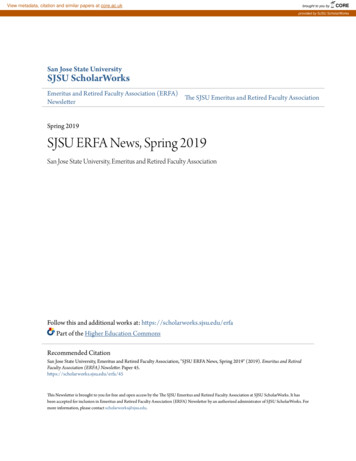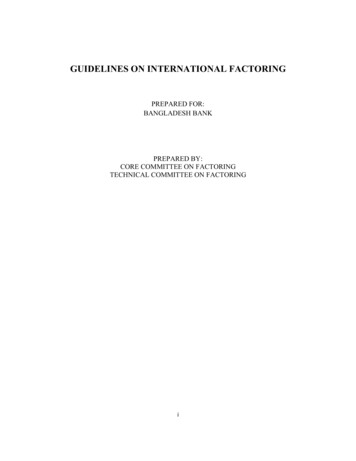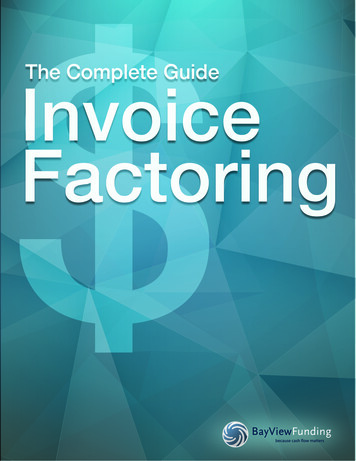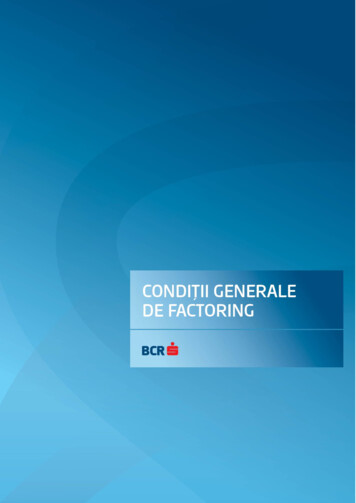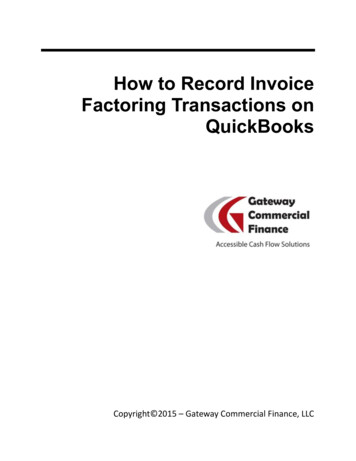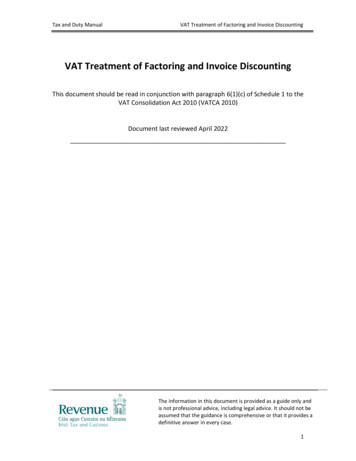
Transcription
FactoringFactoring1
Factoring Security of RSA algorithm depends on(presumed) difficulty of factoringo Given N pq, find p or q and RSA is brokeno Rabin cipher also based on factoring Factoring like “exhaustive search” for RSA Lots of interest/research in factoring What are best factoring methods?o How does RSA “key size” compare to symmetriccipher key size?Factoring2
Factoring Methods Trial divisiono Obvious method but not practical Dixon’s algorithmo Less obvious and much faster Quadratic sieveo Refinement of Dixon’s algorithmo Best algorithm up to about 110 decimal digits Number field sieveo Best for numbers greater than 100 digitso We only briefly mention this algorithmFactoring3
Trial Division Given N, try to divide N by each of2,3,5,7,9,11, , sqrt(N) As soon as a factor found, we are doneo So, expected work is about sqrt(N)/2 Improvement: try only prime numbers Work is then on order of π(N)o Where π(N) N/ln(N) is number of primes up to NFactoring4
Congruence of Squares We want to factor N pq Suppose we find x,y such that N x2 y2 Then N (x y)(x y), have factored N More generally, congruence of squares Suppose x2 y2 (mod N) Then x2 y2 kN for some k Which implies (x y)(x y) kNFactoring5
Congruence of Squares Suppose x2 y2 (mod N) Then (x y)(x y) kN Implies (x y) or (x y) is factor of No Or x y k and x y N (or vice versa) With probability at least 1/2, we obtain afactor of No If so, gcd(N, x y) or gcd(N, x y) factors No And the gcd is easy to computeFactoring6
Congruence of Squares Forexample 102 32 (mod 91) Thatis, (10 3)(10 3) 91o Factors of 91 are, in fact, 7 and 13 Also,342 82 (mod 91)o Then 26 42 0 (mod 91) and we havegcd(26,91) 13 and gcd(42,91) 7 InFactoringgeneral, gcd is necessary7
Congruence of Squares Find congruence of squares: x2 y2 (mod N)and we can likely factor N How to find congruence of squares? Consider, for example,412 32 (mod 1649) and 432 200 (mod 1649) Neither 32 nor 200 is a square But 32 200 6400 802 Therefore, (41 43)2 802 (mod 1649)Factoring8
Congruence of Squares Can combine non-squares to obtain asquare, for example32 25 50 and 200 23 52 And 32 200 28 52 (24 51)2We obtain a perfect square provided eachexponent in product is evenOnly concerned with exponents and onlyneed consider even or odd, i.e., mod 2Factoring9
Congruence of Squares Number has an exponent vectorFor example, first element of vector ispower of 2 and second power of 5 Then AndFactoring10
Congruence of Squares Mod 2 exponent vector of product 200 32is all zero, so perfect squareAlso, this vector is sum (mod 2) of vectorsfor 200 and 32Any set of exponent vectors that sum toall-zero, mod 2, gives us a squareWe need to keep vectors smallo Only allow numbers with “small” prime factorsFactoring11
Congruence of Squares Choose bound B and primes less than Bo This is our factor baseo For technical reasons, include “ 1” in factor base A number that factors completely over thefactor base is B-smooth Smooth relations factor over factor base Restrict our attention to B-smooth relationso Good: Exponent vectors are smallo Bad: Harder to find relationsFactoring12
Example Want to factor N 1829 Choose bound B 13 Choose factor base 1,2,3,5,7,11,13 Look at values in N/2 to N/2 To be systematic, we choose sqrt(kN) and sqrt(kN) for k 1,2,3,4And test each for B-smoothnessFactoring13
Example Compute All are B-smooth except 602 and 752Factoring14
Example ObtainexponentvectorsFactoring15
Example Find collection of exponent vectors thatsum, mod 2, to zero vectorVectors corresponding to 422, 432, 612 and852 workFactoring16
Example Impliesthat(42 43 61 85)2 (2 3 5 7 13)2 (mod 1829) Simplifiesto 14592 9012 (mod 1829) Since1459 901 558, we find factorof 1829 by gcd(558,1829) 31 EasilyFactoringverified 1829 59 3117
Example Asystematic way to find set ofvectors that sum to zero vector Inthis example, want x0,x1, ,x5 ThisFactoringis a basic linear algebra problem18
Linear Algebra Suppose n elements in factor baseo Factor base includes “ 1”o Then matrix on previous slide has n rowso Seek linearly dependent set of columns Theorem: If matrix has n rows and n 1 ormore columns then a linearly dependent setof columns existsTherefore, if we find n 1 or more smoothrelations, we can solve the linear equationsFactoring19
Dixon’s Algorithm1. To factor N: select bound B and factorbase with n 1 primes less than B and “ 1”2. Select r, compute y r2 (mod N)Number r can be selected at random3. If y factors completely over factor base,save mod 2 exponent vector4. Repeat steps 2 and 3 to obtain n 1 vectors5. Solve linear system and compute gcdFactoring20
Dixon’s Algorithm Iffactor base is large, easier to findB-smooth relationso But linear algebra problem is harder Relationfinding phase parallelizableo Linear algebra part is not Next,quadratic sieveo An improved version of Dixon’s algorithmFactoring21
Quadratic Sieve Quadraticsieve (QS) algorithmo Dixon’s algorithm “on steroids” Finding AsB-smooth relations beefed upin Dixon’s algorithmo Choose bound B and factor base ofprimes less than Bo Must find lots of B-smooth relationsFactoring22
Quadratic Sieve Define quadratic polynomialQ(x) ( sqrt(N) x)2 N The is the “quadratic” in QS Use Q(x) to find B-smooth valueso For each x [ M,M] compute y Q(x)o Mod N, we have y z2, where z sqrt(N) xo Test y for B-smoothnesso If y is smooth, save mod 2 exponent vectorFactoring23
Quadratic Sieve Advantageof QS over Dixon’s is thatby using Q(x) we can sieve Whatis sieving? Glad you asked First,consider sieve of Eratostheneso Used to sieve for prime numbers ThenFactoringmodify it for B-smooth numbers24
Sieve of Eratosthenes To find prime numbers less than M List all numbers 2,3,4, ,M 1 Cross out all numbers with factor of 2,other than 2Cross out all numbers with factor of 3,other than 3, and so onNumber that “fall thru” sieve are primeFactoring25
Sieve of Eratosthenes Tofind prime numbers less than 31 23—45— 6—\7 —8 9 10— 13 14 — 15 — 17 18— 19 20—\\ 1611 12 29 30 22 — 23 24 — 25\ 26— 27 28—— \21 Findthat primes less than 31 are2,3,5,7,11,13,17,19,23 and 29Factoring26
Sieve of Eratosthenes This Butsieve gives us primesalso provides info on non-primes For“ example, 24 marked with “ — ” and” so it is divisible by 2 and 3 Note:we only find that 24 is divisibleby 2, not by 4 or 8Factoring27
Sieving for Smooth Numbers Insteadof crossing out, we divide bythe prime (including prime itself)2113421561317849 1031511 126 13 14217 1515 168 17 189 19 1032029 142117 2211 23 12244 255 1326 27282 29 301515 All1s represent 7-smooth numbers Some non-1s also 7-smootho Divide out highest powers of primesFactoring28
Quadratic Sieve QS uses similar sieving strategy as onprevious slideo And some computational refinements Suppose p in factor base divides Q(x)o Then p divides Q(x kp) for all k 0 (homework)o That is, p divides Q of ,x 2p,x p,x,x p,x 2p, o No need to test these for divisibility by p This observation allows us to sieveFactoring29
Quadratic Sieve One trick to speed up sieving If Q(x) divisible by p, then Q(x) 0 (mod p) Defn of Q implies ( sqrt(N) x)2 N (mod p) Square roots of N (mod p), say, sp and p spo Let x0 sp sqrt(N) and x1 p sp sqrt(N) o Then Q(x0) and Q(x1) divisible by po Implies Q(x0 kp) and Q(x1 kp) divisible by p Efficient algorithm for these square rootsFactoring30
Quadratic Sieve How to sieve for B-smooth relations Array: Q(x) for x M, M 1, , M 1,M For first prime p in factor baseo Generate all x [ M,M] for which p divides Q(x)(as described on previous slide)o For each, divide by highest power of po For each, store power, mod 2, in vector for x Repeat for all primes in factor base Numbers reduced to 1 are B-smoothFactoring31
Quadratic Sieve Linear algebra phase same as Dixon’s Sieving is the dominant work Lots of tricks used to speed up sievingo For example, “logarithms” to avoid division Multiple Polynomial QS (MPQS)o Multiple polynomials of form (ax b)2 No Can then use smaller interval [ M,M]o Yields much faster parallel implementationsFactoring32
Sieving Conclusions QS/MPQS attack has two phases Distributed relation finding phaseo Could recruit volunteers on Internet Linear equation solving phaseo For big problems, requires a supercomputer Number field sieve better than QSo Requires 2 phases, like QSo Number field sieve uses advanced mathFactoring33
Factoring Algorithms Work Lastto factor N 2xcolumn measures “bits” of work Symmetriccipher exhaustive keysearch: x bit key is x 1 bits of workFactoring34
Factoring Algorithms Comparisonof work factors QSbest to390 bit No 117 digits 390-bitN isas secure as60-bit keyFactoring35
Factoring Conclusions Workfor factoring is subexponentialo Better than exponential time but worsethan polynomial timeo Exhaustive key search is exponential Factoringis active area of researcho Expect to see incremental improvement Next,Factoringdiscrete log algorithms 36
Factoring 31 Quadratic Sieve How to sieve for B-smooth relations Array: Q(x) for x M, M 1, , M 1,M For first prime p in factor base o . oNumber field sieve uses advanced math. Factoring 34 Factoring Algorithms Work to factor N 2x Last column measures "bits" of work Symmetric cipher exhaustive .
